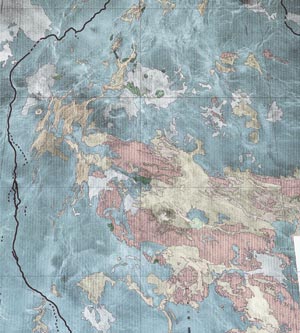Lest We Forget Venus!
During the Magellan Mission to Venus in the 1990s, the Magellan satellite visited Venus and transmitted radar images and altimetric measurements from 97 percent of the planet. These images revealed that, like Earth, Venus has had an active geologic history modifying its surface by volcanism and tectonics. However, unlike Earth, Venus does not appear to be undergoing plate tectonics. A GIS developed by researchers at  Brown University in Providence, Rhode Island, has helped relate the stratigraphic history to the tectonic and topographic history of a region on Venus and sheds some light on what forces drive tectonics on Venus.
Brown University in Providence, Rhode Island, has helped relate the stratigraphic history to the tectonic and topographic history of a region on Venus and sheds some light on what forces drive tectonics on Venus.
Right: A GIS developed by researchers at Brown University has helped relate the stratigraphic history to the tectonic and topographic history of a region on Venus.
Extending ArcView GIS for Mapping Planets
Because ArcView GIS was designed for use on Earth, some modifications were necessary to enable it to display Venus data properly. Peter Girard (also see "Celestial Mapping with GIS"), formerly of Esri-Boston, developed a Projection and Spheroid extension that contains proper spheroid definitions for every large terrestrial body in the solar system. (Unlike Earth, which has an oblate shape, Venus is a spheroid of 6,051 kilometers radius.) The Projection and Spheroid extension also enables longitude to be measured positive west as it is on every planet except Venus and Earth and to range from 0 degrees to 360 degrees instead of -180 to 180 on Earth.
Geologic Map of the Baltis Vallis Region of Venus
Baltis Vallis is a canal, a geologic term for a sinuous channel, one to three kilometers wide and more than 6,800 kilometers long that might have been carved by lava. Baltis Vallis is the longest known channel of any kind in the solar system, and it is formed entirely in a geologic unit mapped as plains with wrinkle ridges. These are interpreted to be widespread basaltic volcanic flows that have undergone compressive strain. The wrinkle ridges show up as bright squiggles on the radar image.
Comparing stratigraphic maps to topographic data of Baltis Vallis and other canals is useful for studying the relationships between stratigraphy and topography because if there were channel flows under gravity, they would originally have had a monotonic gradient (a constant downhill slope from source to end). A comparison between a map of the canals and gridded topography data reveals that the topography of the channel now undulates.
For more information, contact Chris Cooper (e-mail: Christopher_Cooper@brown.edu, tel.: 401-863-3379).
